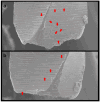Influence of Continuous Rotation and Optimal Torque Reverse Kinematics on the Cyclic Fatigue Strength of Endodontic NiTi Clockwise Cutting Rotary Instruments
- PMID: 39452445
- PMCID: PMC11506770
- DOI: 10.3390/dj12100317
Influence of Continuous Rotation and Optimal Torque Reverse Kinematics on the Cyclic Fatigue Strength of Endodontic NiTi Clockwise Cutting Rotary Instruments
Abstract
Objectives: The objective of the present study was to evaluate the cyclic fatigue strength of clockwise cutting rotary endodontic instruments when subjected to two different kinematics: continuous clockwise rotation and clockwise reciprocation movement under optimum torque reverse (OTR) motion. Methods: New ProTaper Next X1 (n = 20) and X2 (n = 20) instruments were randomly divided into two subgroups (n = 10) based on kinematics (continuous rotation or OTR). The specimens were tested using a custom-made device with a non-tapered stainless-steel artificial canal measuring 19 mm in length, featuring a 6 mm radius and an 86-degree curvature. All instruments were tested with a lubricant at room temperature until a fracture occurred. The time to fracture and the length of the separated fragment were recorded. Subsequently, the fractured instruments were inspected under a scanning electron microscope for signs of cyclic fatigue failure, plastic deformation, and/or crack propagation. The subgroup comparisons for time to fracture and instrument length were performed using the independent samples t-test, with the level of statistical significance set at 0.05. Results: When using OTR movement, the ProTaper Next X1 increased the time to fracture from 52.9 to 125.8 s (p < 0.001), while the ProTaper Next X2 increased from 45.4 to 66.0 s (p < 0.001). No subgroup exhibited plastic deformations, but both showed dimpling marks indicative of cyclic fatigue as the primary mode of failure. Additionally, OTR movement resulted in more metal alloy microcracks. Conclusions: The use of OTR motion extended the lifespan of the tested instruments and resulted in a higher number of metal microcracks. This suggests that OTR motion helped to distribute the mechanical stress more evenly across the instrument, thereby relieving localized tension. As a result, it delayed the formation of a single catastrophic crack, enhancing the overall performance of the instruments during the experimental procedures.
Keywords: cyclic fatigue; endodontics; kinematics; reciprocation; root canal therapy; scanning electron microscope.
Conflict of interest statement
The authors declare no conflicts of interest.
Figures



Similar articles
-
Influence of Kinematics on the Cyclic Fatigue Resistance of Replicalike and Original Brand Rotary Instruments.J Endod. 2020 Aug;46(8):1136-1143. doi: 10.1016/j.joen.2020.05.001. Epub 2020 May 13. J Endod. 2020. PMID: 32413441
-
Influence of continuous rotation or reciprocation of Optimum Torque Reverse motion on cyclic fatigue resistance of nickel-titanium rotary instruments.Int Endod J. 2018 May;51(5):522-528. doi: 10.1111/iej.12769. Epub 2017 Apr 25. Int Endod J. 2018. PMID: 28329416
-
Influence of Continuous or Reciprocating Optimum Torque Reverse Motion on Cyclic Fatigue Resistance of Two Single-File Nickel-Titanium Rotary Instruments.Eur Endod J. 2017 Aug 22;2(1):1-6. doi: 10.14744/eej.2017.17012. eCollection 2017. Eur Endod J. 2017. PMID: 33403337 Free PMC article.
-
Cyclic fatigue resistance of RaCe and Mtwo rotary files in continuous rotation and reciprocating motion.J Endod. 2014 Jul;40(7):995-9. doi: 10.1016/j.joen.2013.12.010. Epub 2014 Mar 6. J Endod. 2014. PMID: 24935551
-
A review of cyclic fatigue testing of nickel-titanium rotary instruments.J Endod. 2009 Nov;35(11):1469-76. doi: 10.1016/j.joen.2009.06.015. Epub 2009 Sep 1. J Endod. 2009. PMID: 19840633 Review.
Cited by
-
The impact of blade geometry (nonflat, flat or hybrid) and metallurgical composition on the mechanical performance of NiTi endodontic instruments: A multimethod laboratory study.Int Endod J. 2025 Aug;58(8):1243-1256. doi: 10.1111/iej.14249. Epub 2025 May 3. Int Endod J. 2025. PMID: 40317569 Free PMC article.
References
-
- Hülsmann M., Peters O.A., Dummer P.M. Mechanical preparation of root canals: Shaping goals, techniques and means. Endod. Top. 2005;10:30–76. doi: 10.1111/j.1601-1546.2005.00152.x. - DOI
-
- Puentes C.G., Jaime A., Versiani M. Evolução dos instrumentos endodônticos: Das limas manuais ao movimento reciprocante. In: De Deus G., Silva E., Souza E., Versiani M., Zuolo M., editors. O Movimento Reciprocante na Endodontia. 1st ed. Quintessence Publishing; São Paulo, Brazil: 2017. pp. 49–75.
LinkOut - more resources
Full Text Sources
Research Materials

